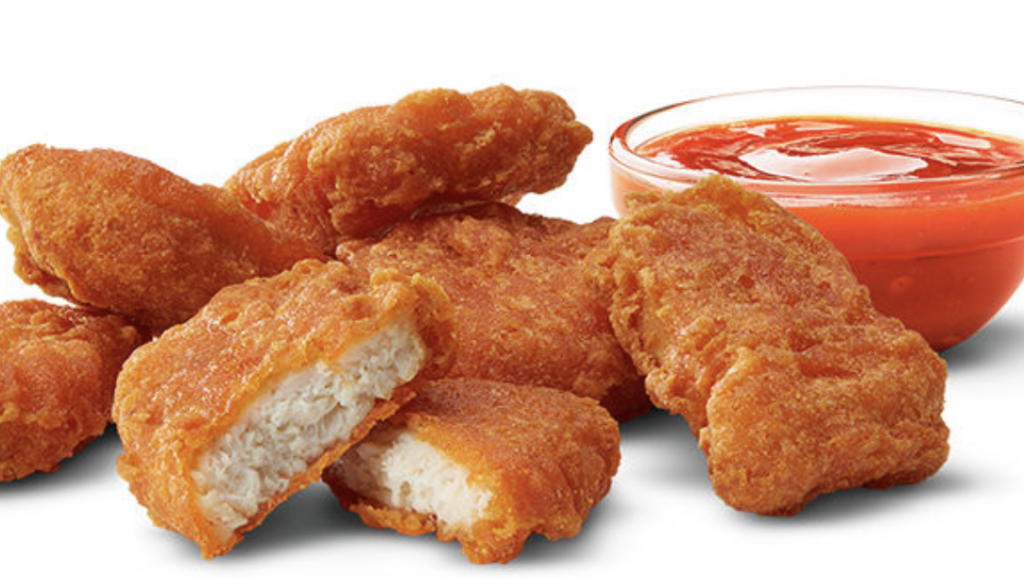The Surprising Fact You Never Knew About McDonald’s Chicken McNuggets
Onion nuggets preceded chicken McNuggets at McDonald's, which have only been around since the 1980s.
This article is more than 2 years old

McDonald’s chicken McNuggets have been around so long, it’s easy to forget that they weren’t part of the restaurant chain’s original menu. In fact, they’ve only been around since the early 1980s, when McDonald’s finally released them nationwide after a lengthy test market trial. What most people don’t know about the famous McNuggets is that they had a vegetarian predecessor that was an epic menu failure.
Chase Shustack of TheDailyMeal looked into the history of the famous McNuggets and discovered that McDonald’s offered another batter-coated, deep-fried finger food before it launched the famous chicken chunks. Believe it or not, Onion Nuggets appeared on McDonald’s menu first. “These Onion Nuggets seemed to be more or less a ‘test product’ meant to attract the vegetarian crowd, with the nuggets being available in select locations across the United States,” said Shustack.
Initially, Onion McNuggets sound rather odd, but they’re basically just another incarnation of the classic onion rings sold at so many fast food establishments. Only available for a brief period between 1978 and 1979, the deep-fried onion chunks just never caught on. “It wasn’t as if people found the Onion Nuggets bad (in fact, some have even petitioned for the nuggets to come back),” said Shustack, “But fried onions didn’t seem to fit McDonald’s style.”
McDonald’s executives decided to hire an expert to help them further expand their menu. They brought on a man named Rene Arend, whose culinary resume was impressive. He had cooked meals for English royalty, which Shustack says made him remarkably overqualified for the job.
Arend was told to develop a chicken product that would be similar to French fries, assumingly easy to grasp and eat without utensils. His first two ideas were delicious and well-received. However, it was determined that a boneless filet and a chicken pot pie couldn’t be mass-produced with the same ease as burgers and fries—at least, not then.
In 1979, Arend created the concept for McDonald’s McNuggets. Shustack describes them as, “golden, crispy, and juicy… a tempura-coated keystone of the average McDonald’s menu.” McDonald’s executives loved that they were delicious and easy to manufacture, and Arend went on to develop another McDonald’s icon: the McRib sandwich.
Alas, it would be over three more years before McDonald’s could release the McNuggets nationwide. There was a chicken supply shortage which, coupled with the demand for the tempura-coated chicken, made nationwide availability impossible. Almost instantly after the chicken shortage ended, McNuggets appeared in restaurants across America and cemented their place in fast food culture.
Of course, every cultural icon generates controversy, and McNuggets are no exception. A common rumor that still surfaces occasionally online is that the crispy chicken pieces are made out of pink slime, a frightening-looking overprocessed paste made of pulverized whole chickens—guts, eyeballs, and all. According to Snopes, this allegation isn’t true, at least not entirely.
Prior to 2003, McDonald’s chicken nuggets were made from mechanically separated chicken meat. This type of meat product does have a paste-like consistency, but it’s only made from edible meat tissue stripped from bones, not entire bird carcasses. Snopes states that in 2003, McDonald’s began making McNuggets out of all-white chicken meat, and continues to this day.
Shustack pointed out another interesting fact about McDonald’s McNuggets that you might not have noticed before. They come in four distinct shapes: a bell, a ball, a boot, and a bowtie. “These ‘shapes’ are from the production process, in which the chicken breast is ‘stamped’ by a ‘cookie cutter’ into one of these four shapes to ensure all resulting nuggets are the same width and size,” he explained, referencing an article published in Reader’s Digest magazine.




